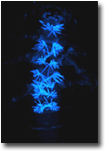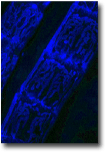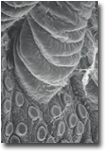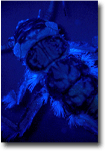|
David
Buchwalter
Postdoctoral Fellow
B.S. Zoology, 1989. University of Massachusetts
M.S. Toxicology, 1994. Oregon State University
Ph.D. Toxicology, 2002. Oregon State University
buchwalt@usgs.gov
Research Interests
Aquatic insects are widely used to evaluate ecosystem health.
As secondarily aquatic organisms, freshwater insects have
evolved several interesting strategies for obtaining oxygen
and maintaining their salt-water balance. As a result, species
differ tremendously with respect to their cellular interface
with the surrounding water. My research focuses on these respiratory
and osmoregulatory systems as they relate to contaminant uptake
from the environment. My PhD work focused on aquatic insect
respiratory biology and pesticide accumulation. Currently,
I’m exploring aquatic insect osmoregulatory physiology
as it relates to heavy metal uptake.
Publications
Buchwalter, D. B., and Luoma, S.
N. (2005) Differences in dissolved cadmium and zinc uptake
among stream insects: Mechanistic Explanations. Environmental
Science and Technology Vol 39, p. 498-504.
Buchwalter, D.B., J. Sahdahl, J.J.
Jenkins, and L.R. Curtis. 2004. Roles of uptake, biotransformation,
and target site sensitivity in determining the differential
toxicity of chlorpyrifos to second to fourth instar Chironomous
riparius (Meigen). Aquatic
Tox. Vol 66 149–157.
Buchwalter, D.B., J.J. Jenkins, and L.R.
Curtis. 2003. Temperature influences on water permeability
and chlorpyrifos uptake in aquatic insects with differing
respriratory strategies. Environ.
Toxicol. Chem. Vol 22 (11) 2806–2812.
Buchwalter, D.B., J.J. Jenkins, and L.R.
Curtis. 2002. Respiratory strategy is a major determinant
of [3H]-H2O and [14C]-chlorpyrifos accumulation in aquatic
insects. Can.
J. Fish. Aquat. Sci. 59: 1315-1322.
Buchwalter, D.B., G. Linder, and L.R.
Curtis. 1996. Modulation of cupric ion activity by pH and
fulvic acid as determinants of toxicity in Xenopus laevis
embryos and larvae. Environ.
Toxicol. Chem., Vol 15 (4) 568-573.
Bantle, J.A., D.T. Burton, D.A. Dawson,
J.N. Dumont, R.A. Finch, D.J. Fort, G. Linder, J.R. Rayburn,
D.B. Buchwalter, M.A. Maurice, and S.D. Turley. 1994. Initial
Interlaboratory Validation Study of FETAX: Phase I Testing.
J. App. Tox. Vol 14(3), 213-223.
Bantle, J.A., D.T. Burton, D.A. Dawson,
J.N. Dumont, R.A. Finch, D.J. Fort, G. Linder, D.B. Buchwalter,
J.R. Rayburn, and S.D. Turley. 1994. FETAX Interlaboratory
Validation Study: Phase II testing. Environ. Toxicol. Chem.,
Vol 13(10) 1629-1637.
|






